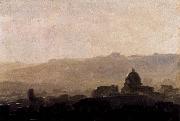Wholesale Oil Painting No Minimum |
|||||||||||
|
|
|||||||||||

|
|||||||||||
|
|
|
||||||||
Pierre de ValenciennesToulouse 1750-Paris 1819 .French painter. He trained at the academy in Toulouse under the history painter Jean-Baptiste Despax (1709-73). In 1769 he went to Italy for the first time, with Mathias Du Bourg, a councillor at the Toulouse parliament. Du Bourg introduced him to Etienne-Fran?ois, Duc de Choiseul, a keen patron of the arts, who in turn recommended him to Gabriel-Fran?ois Doyen, one of the leading history painters in Paris, whose studio he entered in 1773. Doyen gave his pupil a sense of the elevated ideals of history painting but was also sympathetic to the lesser genre of landscape. Valenciennes presumably frequented Choiseul's country seat at Chanteloup, near Amboise, meeting there the landscape painters Hubert Robert and Jean Hoeel, both proteg's of Choiseul. His early interest in the native landscape can be seen in his sketchbooks (Paris, Louvre), especially one dated 1775 that contains drawings made at Amboise, Compiegne and Fontainebleau |
||||||||
|
|
||||||||
View of Rome in the Morning
View of Rome in the Morning Painting ID:: 44021 |
1782-84
Oil on paper laid on board,
18 x 25 cm 1782-84 Oil on paper laid on board, 18 x 25 cm |
|||||||
|
|
||||||||
|
Pierre-Henri de Valenciennes (December 6, 1750 - February 16, 1819) was a French painter. Valenciennes worked in Rome from 1778 to 1782, where he made a number of landscape studies directly from nature, sometimes painting the same set of trees or house at different times of day.He theorized on this idea in Advice to a Student on Painting, Particularly on Landscape (1800), developing a concept of a "landscape portrait" in which the artist paints a landscape directly while looking upon it, taking care to capture its particular details.Although he spoke of this as a type of painting mainly of interest to "amateurs", as distinguished from the higher art of the academies, he found it of great interest, and of his own works the surviving landscape portraits have been the most noted by later commentators. He in particular urged artists to capture the distinctive details of a scene's architecture, dress, agriculture, and so on, in order to give the landscape a sense of belonging to a specific place; in this he probably influenced other French artists active in Italy who took an anthropological approach to painting rural areas and customs, such as Hubert Robert, Pierre-Athanase Chauvin and Achille-Etna Michallon. View of Rome in the Morning 1782(1782) and 1784(1784) Medium Oil on paper laid on board cyf |
||||||||
|
|
||||||||
|
Prev Next
|
||||||||
|
|
||||||||
|
Related Paintings to Pierre-Henri de Valenciennes :. |
||||||||
|
|
||||||||
|
CONTACT US |

